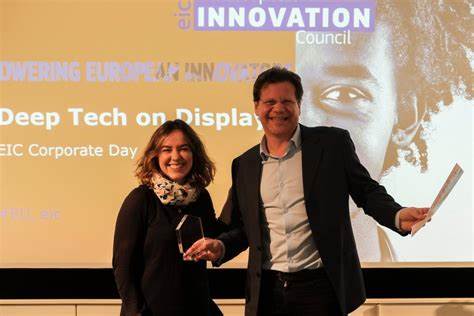KIBBUTZ ZEELIM, Israel — Hawks, vultures and storks circle overhead as Christopher Sveen points at the heap of refuse rotting in the desert heat. “This is the mine of the future,” he beams.
Sveen is chief sustainability officer at UBQ, an Israeli company that has patented a process to convert household trash, diverting waste from landfills into reusable bio-based plastic.
After five years of development, the company is bringing its operations online, with hopes of revolutionizing waste management and being a driver to make landfills obsolete. It remains to be seen, however, if the technology really works and is commercially viable.
UBQ operates a pilot plant and research facility on the edge of southern Israel’s Negev Desert, where it has developed its production line.
“We take something that is not only not useful, but that creates a lot of damage to our planet, and we’re able to turn it into the things we use every day,” said Albert Douer, UBQ’s executive chairman. He said UBQ’s material can be used as a substitute for conventional petrochemical plastics and wood, reducing oil consumption and deforestation.
UBQ has raised $30 million from private investors, including Douer, who is also chief executive of Ajover Darnel Group, an international plastics conglomerate.
Leading experts and scientists serve on its advisory board, including Nobel Prize chemist Roger Kornberg, Hebrew University biochemist Oded Shoseyov, author and entrepreneur John Elkington and Connie Hedegaard, a former European Commissioner for Climate Action.
The small plant can process one ton of municipal waste per hour, a relatively small amount that would not meet the needs of even a midsize city. But UBQ says that given the modularity, it can be quickly expanded.
On a recent day, UBQ Chief Executive Tato Bigio stood alongside bales of sorted trash hauled in from a local landfill.
He said recyclable items like glass, metals and minerals are extracted and sent for further recycling, while the remaining garbage — “banana peels, the chicken bones and the hamburger, the dirty plastics, the dirty cartons, the dirty papers” — is dried and milled into a powder.
The steely gray powder then enters a reaction chamber, where it is broken down and reconstituted as a bio-based plastic-like composite material. UBQ says its closely-guarded patented process produces no greenhouse gas emissions or residual waste byproducts, and uses little energy and no water.
According to the United Nations Environment Program, 5 percent of global greenhouse gas emissions are produced by decomposing organic material in landfills. Roughly half is methane, which over two decades is 86 times as potent for global warming as carbon dioxide, according to the U.N. Intergovernmental Panel on Climate Change.
For every ton of material produced, UBQ says it prevents between three and 30 tons of CO2 from being created by keeping waste out of landfills and decomposing.
UBQ says its material can be used as an additive to conventional plastics. It says 10-15 percent is enough to make a plastic carbon-neutral by offsetting the generation of methane and carbon dioxide in landfills. It can be molded into bricks, beams, planters, cans, and construction materials. Unlike most plastics, UBQ says its material doesn’t degrade when it’s recycled.
The company says converting waste into marketable products is profitable, and likely to succeed in the long run without government subsidies.
“What we do is we try to position ourselves at the end of the value chain, or the end of the waste management hierarchy,” Sveen said. “So rather than that waste going to a landfill or being incinerated, that’s kind of our waste feedstock.”
The wonder plastic isn’t without its skeptics, however. Duane Priddy, chief executive of the Plastic Expert Group, said UBQ’s claims were “too good to be true” and likened it to alchemy.
“Chemists have been trying to convert lead to gold for centuries, without success,” Priddy, a former principal scientist at Dow Chemical, said in an email to The Associated Press. “Likewise, chemists have been trying to convert garbage to plastic for several decades.”
UBQ said it is confident its technology will prove the skeptics wrong. “We understand that’s people’s perceptions. We hope to convince them professionally and scientifically,” Sveen said.
Even if its technology is ultimately successful, UBQ faces questions about its long-term viability. Building additional plants could be expensive and time-consuming. It also needs to prove there is a market for its plastic products. The company said it is negotiating deals with major customers, but declined to identify them or say when the contracts would go into effect.
The U.N. Environment Program has made solid waste disposal a central issue in combatting pollution worldwide. Landfills contaminate air, water and soil, and take up limited land and resources. A December 2017 report by the international body devoted five of its 50 anti-pollution measures to reducing and processing solid waste.
“Every year, an estimated 11.2 billion tons of solid waste are collected worldwide,” the organization says. “The solution, in the first place, is the minimization of waste. Where waste cannot be avoided, recovery of materials and energy from waste as well as remanufacturing and recycling waste into usable products should be the second option.”
Israel lags behind other developed countries in waste disposal. The country of roughly 8 million people generated 5.3 million metric tons of garbage in 2016, according to the Environment Ministry. Over 80 percent of that trash ended up in increasingly crowded landfills. A third of Israel’s landfill garbage is food scraps, which decompose and produce greenhouse gases like methane and carbon dioxide.
To UBQ, that means a nearly limitless supply of raw materials.
“The fact is that the majority of waste goes to a landfill or is leaked into our natural environments because there simply aren’t holistic and economically viable technologies out there,” said Sveen.
The article is no longer available at The New York Times – but read more at source/AP.


